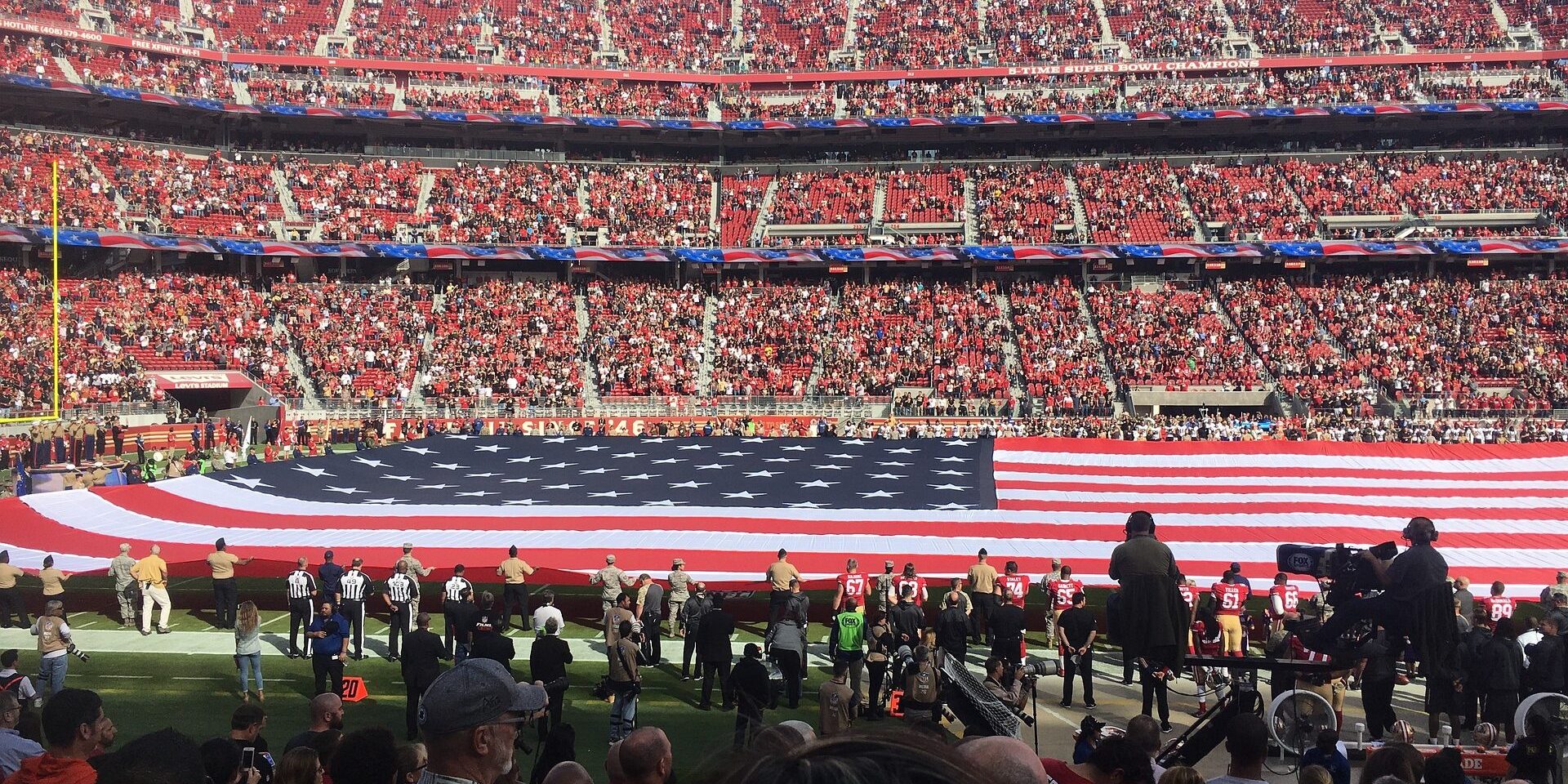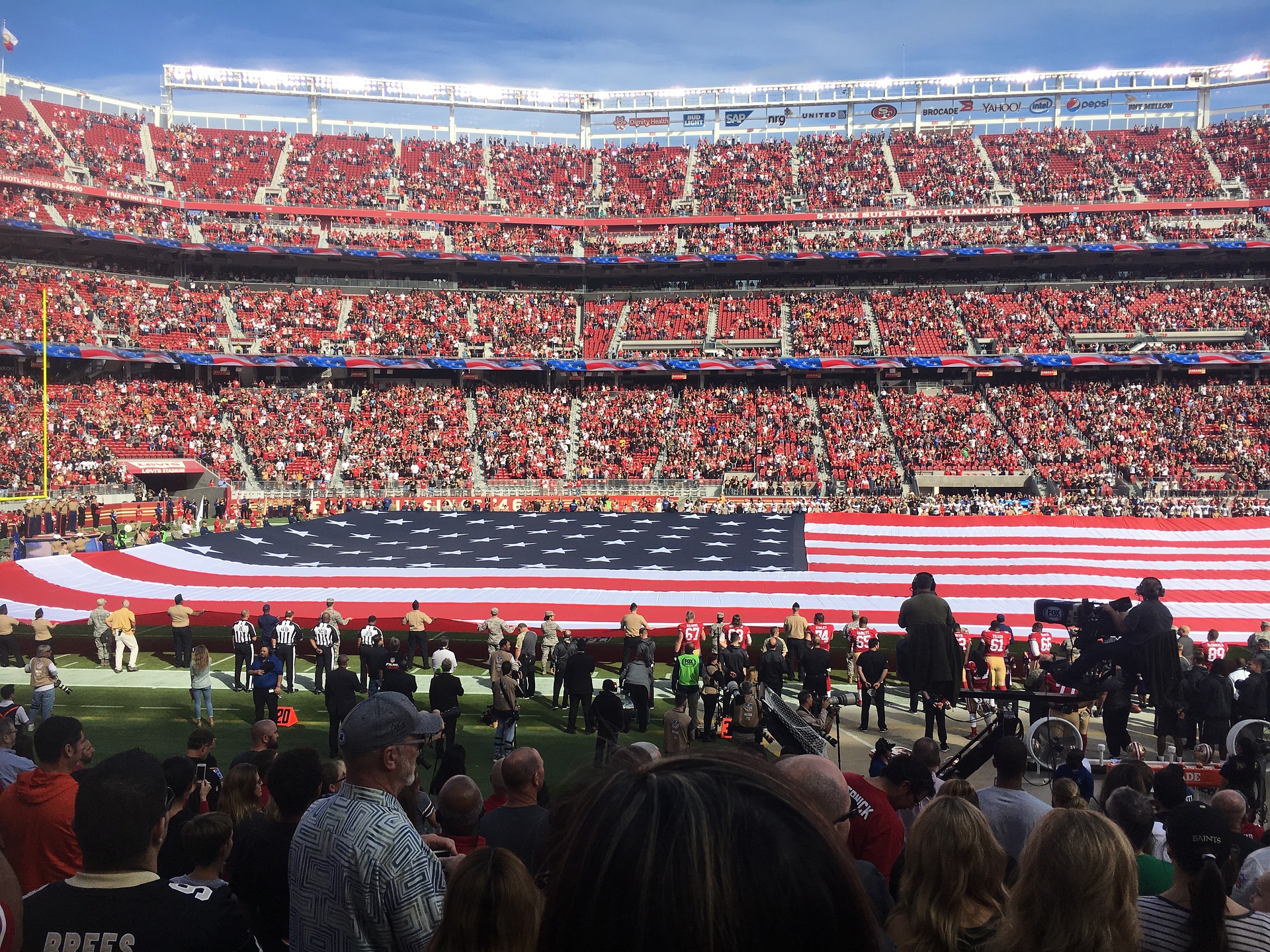How Does The NFL Playoff Bracket Work?


The National Football League (NFL) is a professional American football league consisting of 32 teams, divided equally between the National Football Conference (NFC) and the American Football Conference (AFC). At the end of the regular season, the playoffs begin, culminating in the Super Bowl, which determines the league champion. But how does the NFL playoff bracket work?
The playoffs consist of a single-elimination tournament, beginning with the Wild Card Round. In this round, the four teams with the best records in each conference who did not win their division compete against each other. The winners of these games advance to the Divisional Round, where they face the top seed in their conference. The Divisional Round determines which teams will advance to the Conference Championships. The winners of the Conference Championships then face off in the Super Bowl to determine the league champion.
The playoffs are an exciting and highly anticipated time for football fans, as the best teams in the league compete for a chance at the ultimate prize. Understanding the structure of the playoff bracket is key to following and enjoying the action.
NFL Regular Season Format Explained
The National Football League (NFL) regular season is a crucial part of the league’s annual calendar, as it determines which teams will qualify for the playoffs and have a chance to compete for the Super Bowl. Here is an overview of the regular season format:
Number of Teams and Length of Season
The NFL consists of 32 teams, divided equally between the National Football Conference (NFC) and the American Football Conference (AFC). Each team plays a total of 16 games over the course of the regular season, which typically begins in early September and ends in late December.
Divisional Structure
Each conference is further divided into four divisions: North, South, East, and West. Within each division, the teams play a total of six games against their divisional opponents (for a total of 24 games). The remaining eight games on a team’s schedule are played against non-divisional opponents from the other conference.
Determining the Playoffs
At the end of the regular season, the playoffs begin. The playoffs consist of a single-elimination tournament, in which the top six teams from each conference qualify. The top seed from each conference earns a bye in the Wild Card Round and advances directly to the Divisional Round. The remaining teams are ranked by their record, with the highest seeds facing the lowest seeds.
Tiebreakers
In the event that two or more teams have the same record at the end of the regular season, certain tiebreakers are used to determine which team advances to the playoffs. The first tiebreaker is head-to-head record, followed by division record and then conference record. If the tie cannot be broken using these methods, a series of tiebreakers involving points scored and allowed are used.
Conclusion
The NFL regular season is a crucial part of the league’s annual calendar, as it determines which teams will qualify for the playoffs and have a chance to compete for the Super Bowl. The league’s 32 teams are divided into two conferences and four divisions, and each team plays a total of 16 games over the course of the season. The playoffs consist of a single-elimination tournament, in which the top six teams from each conference qualify. Tiebreakers are used to determine which teams advance in the event of a tie.
NFL Wild Card Round Explained
The Wild Card Round of the National Football League (NFL) playoffs is the opening round of the postseason, and it features the four teams from each conference who did not win their division but had the best record among the non-division winners. Here is an overview of the Wild Card Round:
Format
The Wild Card Round is a single-elimination format, with the highest seed facing the lowest seed and the second highest seed facing the second lowest seed. The winners of these games advance to the Divisional Round, where they face the top seed in their conference.
Number of Teams
The Wild Card Round features a total of eight teams: four from the NFC and four from the AFC. These teams are ranked by their record, with the highest seeds facing the lowest seeds.
Seeding
The seeding for the Wild Card Round is determined by the teams’ record at the end of the regular season. The highest seed among the non-division winners in each conference is awarded to the team with the best record, while the other seeds are determined by record in descending order.
Home Field Advantage
In the Wild Card Round, the team with the higher seed is awarded home field advantage, meaning they will host the game at their stadium. In the event of a tie in seed, the team with the better record is awarded home field advantage.
Importance
The Wild Card Round is an important part of the NFL playoffs, as it is the first opportunity for teams to advance to the next round. The winners of the Wild Card Round move on to the Divisional Round, where they face the top seed in their conference. The Wild Card Round is also the first chance for underdogs to make a statement and potentially upset a higher seed.
Conclusion
The Wild Card Round of the NFL playoffs is the opening round of the postseason, featuring the four teams from each conference who did not win their division but had the best record among the non-division winners. It is a single-elimination format, with the highest seed facing the lowest seed and the second highest seed facing the second lowest seed. The winners of these games advance to the Divisional Round, where they face the top seed in their conference. Home field advantage is awarded to the higher seed, and the Wild Card Round is an important opportunity for teams to advance to the next round and for underdogs to make a statement.
NFL Divisional Round Explained
The Divisional Round of the National Football League (NFL) playoffs is the second round of the postseason, and it features the four teams from each conference who won their division and the two winners from the Wild Card Round. Here is an overview of the Divisional Round:
Format
The Divisional Round is a single-elimination format, with the highest seed facing the lowest seed and the second highest seed facing the second lowest seed. The winners of these games advance to the Conference Championships, where they face the top seed in their conference.
Number of Teams
The Divisional Round features a total of eight teams: four from the NFC and four from the AFC. These teams are ranked by their record, with the highest seeds facing the lowest seeds.
Seeding
The seeding for the Divisional Round is determined by the teams’ record at the end of the regular season. The top seed in each conference is awarded to the team with the best record, while the other seeds are determined by record in descending order. The two winners from the Wild Card Round are then placed into the remaining seeds.
Home Field Advantage
In the Divisional Round, the team with the higher seed is awarded home field advantage, meaning they will host the game at their stadium. In the event of a tie in seed, the team with the better record is awarded home field advantage.
Importance
The Divisional Round is an important part of the NFL playoffs, as it is the first opportunity for teams to compete for a spot in the Conference Championships. The winners of the Divisional Round move on to the Conference Championships, where they face the top seed in their conference. The Divisional Round is also the first chance for underdogs who advanced from the Wild Card Round to potentially upset a higher seed.
Conclusion
The Divisional Round of the NFL playoffs is the second round of the postseason, featuring the four teams from each conference who won their division and the two winners from the Wild Card Round. It is a single-elimination format, with the highest seed facing the lowest seed and the second highest seed facing the second lowest seed. The winners of these games advance to the Conference Championships, where they face the top seed in their conference. Home field advantage is awarded to the higher seed, and the Divisional Round is an important opportunity for teams to compete for a spot in the Conference Championships and for underdogs who advanced from the Wild Card Round to potentially upset a higher seed.
NFL Conference Championships Explained
The Conference Championships of the National Football League (NFL) playoffs are the third round of the postseason, and they determine which two teams from each conference will advance to the Super Bowl. Here is an overview of the Conference Championships:
Format
The Conference Championships are a single-elimination format, with the highest seed facing the lowest seed. The winners of these games advance to the Super Bowl, where they will face the winner from the other conference.
Number of Teams
The Conference Championships feature a total of four teams: two from the NFC and two from the AFC. These teams are ranked by their record, with the highest seed facing the lowest seed.
Seeding
The seeding for the Conference Championships is determined by the teams’ record at the end of the regular season. The top seed in each conference is awarded to the team with the best record, while the other seed is determined by record in descending order. The winners from the Divisional Round are then placed into the remaining seeds.
Home Field Advantage
In the Conference Championships, the team with the higher seed is awarded home field advantage, meaning they will host the game at their stadium. In the event of a tie in seed, the team with the better record is awarded home field advantage.
Importance
The Conference Championships are an extremely important part of the NFL playoffs, as they determine which two teams from each conference will advance to the Super Bowl. The winners of the Conference Championships move on to the Super Bowl, where they will face the winner from the other conference. The Conference Championships are also the final opportunity for teams to compete for a spot in the Super Bowl and the last chance for underdogs to potentially upset a higher seed.
Conclusion
The Conference Championships of the NFL playoffs are the third round of the postseason, and they determine which two teams from each conference will advance to the Super Bowl. They are a single-elimination format, with the highest seed facing the lowest seed. The winners of these games advance to the Super Bowl, where they will face the winner from the other conference. Home field advantage is awarded to the higher seed, and the Conference Championships are an extremely important part of the playoffs, as they determine which teams will advance to the Super Bowl and provide the final opportunity for underdogs to potentially upset a higher seed.
NFL Super Bowl Explained
The Super Bowl is the annual championship game of the National Football League (NFL), played each year to determine the league’s champion. It is the culmination of the NFL season, and it is one of the biggest events in American sports. Here is an overview of the Super Bowl, including some notable matches and interesting stats:
Format
The Super Bowl is a single-elimination game, featuring the winners of the NFC Championship and the AFC Championship. The game is played at a neutral site chosen through a bidding process, and the winner is awarded the Vince Lombardi Trophy.
Number of Teams
The Super Bowl features a total of two teams: one from the NFC and one from the AFC. These teams are the winners of the Conference Championships, and they are ranked by their record.
Seeding
The seeding for the Super Bowl is determined by the teams’ record at the end of the regular season. The top seed in each conference is awarded to the team with the best record, while the other seed is determined by record in descending order. The winners from the Divisional Round and Conference Championships are then placed into the remaining seeds.
Home Field Advantage
In the Super Bowl, there is no home field advantage, as the game is played at a neutral site.
Notable Super Bowl Matches
There have been many memorable Super Bowls throughout the history of the NFL. Some notable examples include:
- Super Bowl III: This game featured the New York Jets and the Baltimore Colts, and it is notable for the Jets’ upset victory over the heavily favored Colts. The game is also remembered for Jets quarterback Joe Namath’s guarantee of a win before the game.
- Super Bowl XXIII: This game featured the San Francisco 49ers and the Cincinnati Bengals, and it is notable for the 49ers’ last-minute drive to win the game. The drive was led by quarterback Joe Montana, who was named Super Bowl MVP for his performance.
- Super Bowl XLII: This game featured the New York Giants and the New England Patriots, and it is notable for the Giants’ upset victory over the undefeated Patriots. The game is also remembered for the Giants’ game-winning drive, led by quarterback Eli Manning.
Interesting Super Bowl Stats
- The most points scored by a single team in a Super Bowl is 55, achieved by the San Francisco 49ers in Super Bowl XXIV.
- The largest margin of victory in a Super Bowl is 45 points, achieved by the Chicago Bears in Super Bowl XX.
- The most points scored in a Super Bowl overall is 75, achieved in Super Bowl XXIV.
- The most Super Bowl appearances by a single team is 10, achieved by the New England Patriots.
- The most Super Bowl victories by a single team is 7, achieved by the Pittsburgh Steelers.
Conclusion
The Super Bowl is the annual championship game of the National Football League (NFL), played each year to determine the league’s champion. It is a single-elimination game, featuring the winners of the NFC Championship and the AFC Championship. The game is played at a neutral site, and the winner is awarded the Vince Lombardi Trophy. There have been many memorable Super Bowls throughout the history of the NFL, including the Jets’ upset victory over the Colts in Super Bowl III, the 49ers’ last-minute drive to win in Super Bowl XXIII, and the Giants’ upset victory over the undefeated Patriots in Super Bowl XLII. The Super Bowl also has some interesting stats, including the most points scored by a single team and the largest margin of victory.
How Does The NFL Playoff Bracket Work? – Key Takeaways
In conclusion, the National Football League (NFL) playoffs are a highly anticipated and exciting time for football fans. The playoffs consist of a single-elimination tournament, beginning with the Wild Card Round and continuing through the Divisional Round, Conference Championships, and culminating in the Super Bowl. The Super Bowl is the annual championship game, played to determine the league’s champion and featuring the winners of the NFC Championship and the AFC Championship.
Some key takeaways from the NFL playoffs include:
- The playoffs consist of a single-elimination tournament, beginning with the Wild Card Round and continuing through the Divisional Round, Conference Championships, and culminating in the Super Bowl.
- The Super Bowl is the annual championship game, played to determine the league’s champion and featuring the winners of the NFC Championship and the AFC Championship.
- The top seed in each conference is awarded to the team with the best record, while the other seeds are determined by record in descending order.
- The team with the higher seed is awarded home field advantage in the Wild Card Round, Divisional Round, and Conference Championships.
- The Super Bowl is played at a neutral site, and the winner is awarded the Vince Lombardi Trophy.
Overall, the NFL playoffs are a thrilling and highly competitive part of the league’s annual calendar, and they culminate in the highly anticipated and prestigious Super Bowl.
How Does The NFL Playoff Bracket Work? – FAQs
How many teams qualify for the NFL playoffs?
A total of 12 teams qualify for the NFL playoffs: six from the National Football Conference (NFC) and six from the American Football Conference (AFC).
How are the teams seeded in the NFL playoffs?
The seeds are determined by the teams’ record at the end of the regular season. The top seed in each conference is awarded to the team with the best record, while the other seeds are determined by record in descending order.
What is the format of the NFL playoffs?
The playoffs consist of a single-elimination tournament, beginning with the Wild Card Round and continuing through the Divisional Round, Conference Championships, and culminating in the Super Bowl.
How many games are played in the NFL playoffs?
The number of games played in the playoffs depends on how far a team advances. In total, there are 11 playoff games: four in the Wild Card Round, four in the Divisional Round, two in the Conference Championships, and one in the Super Bowl.
Who gets home field advantage in the NFL playoffs?
The team with the higher seed is awarded home field advantage in the Wild Card Round, Divisional Round, and Conference Championships. In the Super Bowl, there is no home field.





